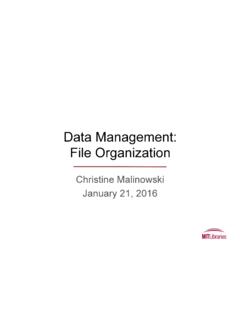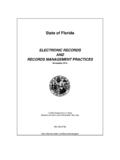Transcription of C# Coding Standards and Best Programming Practices
1 C# Coding Standards and best Programming Practices By 1. 2. License, Copyrights and 3. Revision 4. 5. Purpose of Coding Standards and best 6. How to follow the Standards across the 7. naming Conventions and 8. Indentation and 9. Good Programming 10. 11. 12. 13. Exception 1. Author This document is prepared by the dotnetspider team. Latest version of this document can be downloaded from Please post your comments and feedback about this document in the above url. Most of the information in this document is compiled from the Coding Standards and best Practices published in various articles in Also, we referred to the guidelines published by Microsoft and various other sources.
2 2. License, Copyrights and Disclaimer You are permitted to use and distribute this document for any non commercial purpose as long as you retain this license & copyrights information. This document is provided on As-Is basis. The author of this document will not be responsible for any kind of loss for you due to any inaccurate information provided in this document. 3. Revision History If you are editing this document, you are required to fill the revision history with your name and time stamp so that anybody can easily distinguish your updates from the original author. Sl# Date Changed By Description 1. 4. Introduction Anybody can write code.
3 With a few months of Programming experience, you can write 'working applications'. Making it work is easy, but doing it the right way requires more work, than just making it work. Believe it, majority of the programmers write 'working code', but not good code'. Writing 'good code' is an art and you must learn and practice it. Everyone may have different definitions for the term good code'. In my definition, the following are the characteristics of good code. Reliable Maintainable Efficient Most of the developers are inclined towards writing code for higher performance, compromising reliability and maintainability.
4 But considering the long term ROI (Return On Investment), efficiency and performance comes below reliability and maintainability. If your code is not reliable and maintainable, you (and your company) will be spending lot of time to identify issues, trying to understand code etc throughout the life of your application. 5. Purpose of Coding Standards and best Practices To develop reliable and maintainable applications, you must follow Coding Standards and best Practices . The naming conventions, Coding Standards and best Practices described in this document are compiled from our own experience and by referring to various Microsoft and non Microsoft guidelines.
5 There are several Standards exists in the Programming industry. None of them are wrong or bad and you may follow any of them. What is more important is, selecting one standard approach and ensuring that everyone is following it. 6. How to follow the Standards across the team If you have a team of different skills and tastes, you are going to have a tough time convincing everyone to follow the same Standards . The best approach is to have a team meeting and developing your own Standards document. You may use this document as a template to prepare your own document. Distribute a copy of this document (or your own Coding standard document) well ahead of the Coding Standards meeting.
6 All members should come to the meeting prepared to discuss pros and cons of the various points in the document. Make sure you have a manager present in the meeting to resolve conflicts. Discuss all points in the document. Everyone may have a different opinion about each point, but at the end of the discussion, all members must agree upon the standard you are going to follow. Prepare a new Standards document with appropriate changes based on the suggestions from all of the team members. Print copies of it and post it in all workstations. After you start the development, you must schedule code review meetings to ensure that everyone is following the rules.
7 3 types of code reviews are recommended: 1. Peer review another team member review the code to ensure that the code follows the Coding Standards and meets requirements. This level of review can include some unit testing also. Every file in the project must go through this process. 2. Architect review the architect of the team must review the core modules of the project to ensure that they adhere to the design and there is no big mistakes that can affect the project in the long run. 3. Group review randomly select one or more files and conduct a group review once in a week. Distribute a printed copy of the files to all team members 30 minutes before the meeting.
8 Let them read and come up with points for discussion. In the group review meeting, use a projector to display the file content in the screen. Go through every sections of the code and let every member give their suggestions on how could that piece of code can be written in a better way. (Don't forget to appreciate the developer for the good work and also make sure he does not get offended by the group attack !). 7. naming Conventions and Standards Note : The terms Pascal Casing and Camel Casing are used throughout this document. Pascal Casing - First character of all words are Upper Case and other characters are lower case.
9 Example: BackC. ackColor Camel Casing - First character of all words, except the first word are Upper Case and other characters are lower case. Example: backC. ackColor 1. Use Pascal casing for Class names public class HelloWorld {.. }. 2. Use Pascal casing for Method names void SayHello(string name). {.. }. 3. Use Camel casing for variables and method parameters int totalCount = 0;. void SayHello(string name). {. string fullMessage = "Hello " + name;.. }. 4. Use the prefix I with Camel Casing for interfaces ( Example: IEntity ). 5. Do not use Hungarian notation to name variables. In earlier days most of the programmers liked it - having the data type as a prefix for the variable name and using m_ as prefix for member variables.
10 Eg: string m_sName;. int nAge;. However, in .NET Coding Standards , this is not recommended. Usage of data type and m_ to represent member variables should not be used. All variables should use camel casing. Some programmers still prefer to use the prefix m_ to represent member variables, since there is no other easy way to identify a member variable. 6. Use Meaningful, descriptive words to name variables. Do not use abbreviations. Good: string address int salary Not Good: string nam string addr int sal 7. Do not use single character variable names like i, n, s etc. Use names like index, temp One exception in this case would be variables used for iterations in loops: for ( int i = 0; i < count; i++ ).





